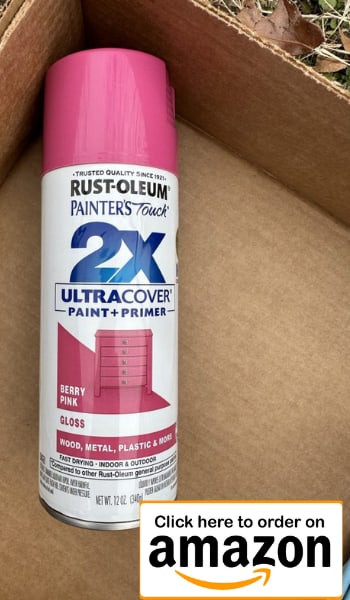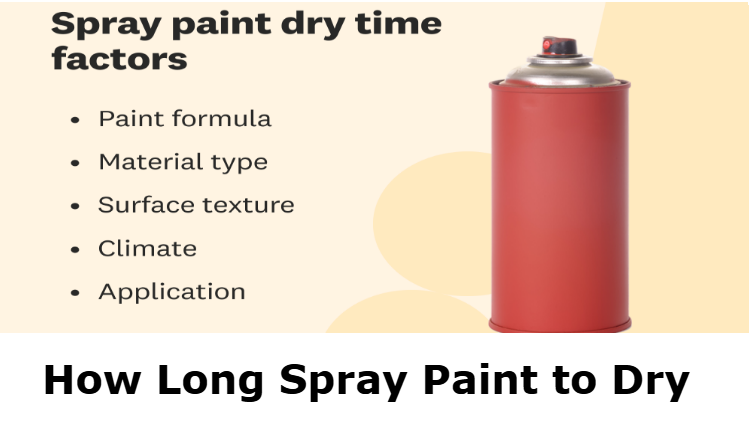Spray painting is a popular method for achieving a smooth, even coat on various surfaces. Understanding drying times helps ensure a quality finish. Factors like temperature, humidity, and paint type influence drying time. Fast-drying paints can dry quickly, but always check the manufacturer’s instructions.
Properly preparing the surface and applying thin coats can also speed up the drying process. Rushing can lead to imperfections like runs or drips. Patience is key for a professional-looking result. Whether you’re a DIY enthusiast or a professional, knowing how long spray paint takes to dry is essential for project success.
Factors Affecting Drying Time
Understanding the factors affecting drying time of spray paint can save you trouble. Drying time can vary depending on several elements. Below, we delve into the critical factors that influence how quickly spray paint dries.
Type Of Paint
The type of paint you use greatly impacts drying time. For example, lacquer-based paints dry faster. They can take just a few minutes to become touch-dry. In contrast, enamel paints may take several hours to dry. Acrylic paints usually dry within 20 minutes. Always check the label for specific drying times.
Surface Material
The surface material also affects how long spray paint takes to dry. Porous surfaces like wood absorb paint, causing it to dry faster. Non-porous surfaces like metal or plastic may take longer. Here’s a quick comparison:
| Surface Material | Estimated Drying Time |
|---|---|
| Wood | 15-30 minutes |
| Metal | 1-2 hours |
| Plastic | 30-60 minutes |
Weather Conditions
Weather conditions can speed up or slow down drying time. High humidity levels increase drying time. Low humidity speeds it up. Temperature also plays a role. Paint dries faster in warm weather. It takes longer in cold weather. Wind can help paint dry faster too. Always aim for optimal conditions when painting outside.
In summary, understanding these factors can help you plan your painting projects better. Always consider the type of paint, surface material, and weather conditions. By doing so, you can achieve the best results in the shortest time possible.

Quick Tips For Faster Drying
Spray paint can be tricky with drying times. Speed up the process with some quick tips. This section will guide you on how to achieve faster drying times.
Thin Coats
Applying thin coats of spray paint helps it dry faster. Thick coats make the paint take longer to dry. Here are some tips:
- Hold the spray can 6-8 inches from the surface.
- Spray in a sweeping motion.
- Apply multiple thin layers instead of one thick layer.
Proper Ventilation
Proper ventilation speeds up drying time. Good airflow helps the paint dry quicker. Consider these options:
- Paint outdoors if possible.
- Open windows and doors in the workspace.
- Use fans to circulate air.
Use Of Fans
Using fans can significantly reduce drying time. Fans help evaporate the solvents in the paint faster. Follow these steps:
- Place fans around the painted object.
- Set fans to medium or high speed.
- Ensure the fans are not too close to avoid dust sticking to the paint.
By following these quick tips, you can make your spray painting projects go smoother and finish faster. Always remember, patience and proper technique are key!
Drying Times For Different Paints
Spray paint drying times can vary widely depending on the type of paint used. Understanding these differences can help you achieve better results in your projects. Below, we explore the drying times for three popular types of spray paints: acrylic, enamel, and lacquer.
Acrylic Spray Paint
Acrylic spray paint is popular for its versatility and quick drying time. It typically dries to the touch within 10 to 30 minutes. Full curing usually takes about 24 hours.
Here is a quick overview of drying times for acrylic spray paint:
| Drying Stage | Time |
|---|---|
| Touch Dry | 10-30 minutes |
| Handle Dry | 1-2 hours |
| Fully Cured | 24 hours |
Enamel Spray Paint
Enamel spray paint provides a hard, glossy finish. It takes longer to dry than acrylic paint. Touch dry time is usually around 30 minutes to 1 hour. Full curing can take up to 7 days.
Here is a quick overview of drying times for enamel spray paint:
| Drying Stage | Time |
|---|---|
| Touch Dry | 30 minutes – 1 hour |
| Handle Dry | 2-3 hours |
| Fully Cured | 7 days |
Lacquer Spray Paint
Lacquer spray paint is known for its fast drying times. It dries to the touch within 5 to 10 minutes. Full curing is generally achieved within a few hours.
Here is a quick overview of drying times for lacquer spray paint:
| Drying Stage | Time |
|---|---|
| Touch Dry | 5-10 minutes |
| Handle Dry | 1 hour |
| Fully Cured | 3 hours |
:max_bytes(150000):strip_icc()/how-to-spray-paint-furniture-5198299-10-2ecc9ce724ac45589e8083c06300f2c0.jpg)
Surface Preparation
Proper surface preparation is essential for achieving the best results with spray paint. Ensuring a clean, primed, and well-sanded surface can significantly impact the drying time and the final finish.
Cleaning The Surface
Before spray painting, always start by cleaning the surface. Dirt, dust, and grease can affect paint adhesion.
- Use a mild detergent and water to wash the surface.
- Rinse thoroughly and let it dry completely.
- For metal surfaces, use a degreaser to remove oil and grease.
Priming The Surface
Applying a primer can help the paint adhere better and last longer. It also helps in achieving an even finish.
- Choose a primer suitable for the material you are painting.
- Shake the primer can well before use.
- Apply a thin, even coat of primer.
- Let the primer dry completely as per the manufacturer’s instructions.
Sanding Techniques
Sanding is an important step in surface preparation. It helps in creating a smooth surface for painting.
- Use fine-grit sandpaper (220-320 grit) for sanding.
- Sand in a circular motion to avoid scratches.
- Wipe off the dust with a tack cloth after sanding.
Following these steps will ensure a smooth and even application of spray paint, leading to quicker drying times and a better finish.
Ideal Weather Conditions
Understanding the ideal weather conditions for spray painting can save time and effort. Weather impacts the drying time of spray paint. Painting in the right conditions ensures a smooth, even coat.
Humidity Levels
Humidity affects spray paint drying times. High humidity levels slow down the drying process. Low humidity, on the other hand, speeds it up. Aim for a humidity level between 40% and 50% for best results. Using a dehumidifier indoors can help control humidity.
Optimal Temperature
Temperature plays a key role in spray paint drying. The optimal temperature range is between 65°F and 85°F. Spray paint dries faster in warmer temperatures. Avoid painting in temperatures below 50°F. Cold weather can cause the paint to crack.
Avoiding Windy Days
Wind can ruin your spray paint job. It can blow dust and debris onto wet paint. This can lead to an uneven surface. Strong winds can also cause overspray. This leads to paint getting on unintended areas. Choose a calm day for your spray painting project.
Common Mistakes To Avoid
Spray painting can be tricky. Knowing the common mistakes to avoid helps. This guide will focus on three main areas: overlapping coats, inadequate drying time, and improper storage. Avoid these mistakes to achieve a smooth, professional finish.
Overlapping Coats
A frequent mistake is overlapping coats too much. This can cause runs and drips. Always aim for even coverage. Use light, even strokes. Hold the spray can 6-8 inches from the surface. Overlapping by 50% is ideal. This ensures consistent coverage without buildup.
Inadequate Drying Time
Inadequate drying time is another common mistake. Rushing the process can ruin the finish. Always follow the manufacturer’s guidelines for drying times. Factors like humidity and temperature affect drying time. Create a table for quick reference:
| Condition | Drying Time |
|---|---|
| Low Humidity | 10-15 minutes |
| High Humidity | 20-30 minutes |
| Cool Temperature | 30-40 minutes |
| Warm Temperature | 15-25 minutes |
Improper Storage
Improper storage of spray paint can also cause issues. Store cans in a cool, dry place. Avoid direct sunlight and extreme temperatures. Ensure the cap is tightly sealed to prevent clogging. Check the expiration date before use. Old paint may not perform well.
Tools To Aid Drying
Spray paint can take hours or even days to dry completely. There are tools you can use to speed up this process. These tools help ensure a smooth, even finish. Here are some effective tools to aid drying:
Heat Guns
Heat guns blow hot air onto the painted surface. This speeds up the drying process.
- Set the heat gun to a low setting.
- Hold it 6-12 inches away from the paint.
- Move it in a circular motion.
Be careful not to hold the heat gun in one spot. This can cause the paint to bubble or crack.
Infrared Lamps
Infrared lamps use heat to dry paint quickly. They are safe and effective.
- Place the lamp close to the painted surface.
- Ensure the lamp covers the entire area.
- Leave it on for the recommended time.
Infrared lamps are great for large projects. They provide even heat distribution.
Dehumidifiers
Dehumidifiers remove moisture from the air. This helps paint dry faster.
- Place the dehumidifier in the room with the painted item.
- Set it to a low humidity level.
- Leave it running until the paint is dry.
A dehumidifier is especially useful in humid climates. It helps maintain a dry environment.
| Tool | Usage | Benefits |
|---|---|---|
| Heat Gun | Blows hot air | Speeds up drying |
| Infrared Lamp | Uses heat | Even heat distribution |
| Dehumidifier | Removes moisture | Maintains dry environment |
Using these tools can greatly reduce drying time. They ensure a professional finish for your spray-painted projects.

Testing Paint Dryness
Testing the dryness of spray paint is crucial. It ensures your project is ready for the next step. Various simple tests can help determine if the paint is dry.
Touch Test
The touch test is the easiest method. Lightly press your finger on a painted spot. If it feels dry and leaves no residue, the paint is dry. If it feels sticky or leaves a mark, it needs more time.
Tape Test
The tape test helps ensure the paint’s adherence. Stick a piece of tape on the painted area. Press it down firmly, then quickly pull it off. If no paint comes off with the tape, the paint is dry. If paint comes off, more drying time is needed.
Scratch Test
The scratch test checks the paint’s toughness. Lightly scratch the painted area with your fingernail. If it scratches easily, the paint is not fully dry. If it resists scratching, the paint is dry and durable.
Frequently Asked Questions
How Long Does Spray Paint Take To Dry?
Spray paint typically takes 30 minutes to dry to the touch. However, it can take up to 24 hours to fully cure.
Can Humidity Affect Spray Paint Drying Time?
Yes, high humidity can significantly slow down the drying process. For best results, spray paint in a low-humidity environment.
Does Temperature Impact Spray Paint Drying?
Yes, temperature plays a crucial role. Ideal conditions are between 65°F and 85°F. Colder temperatures slow drying time.
How Many Coats Of Spray Paint Should I Apply?
Two to three thin coats are usually sufficient. Make sure to let each coat dry before applying the next one.
Conclusion
Understanding how long spray paint takes to dry is crucial for any project. Factors like humidity, temperature, and paint type all matter. Always follow the manufacturer’s guidelines for best results. Patience ensures a smooth, professional finish. Happy painting and enjoy your beautifully transformed surfaces!
